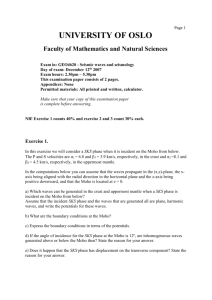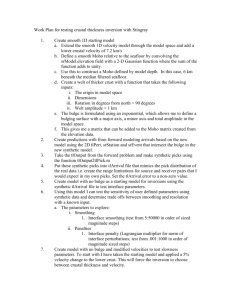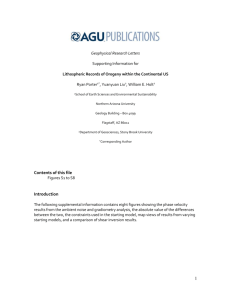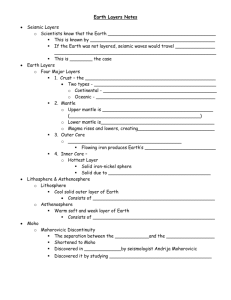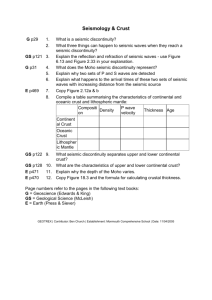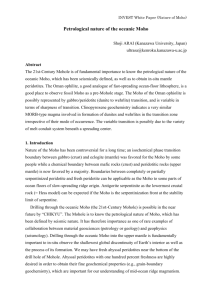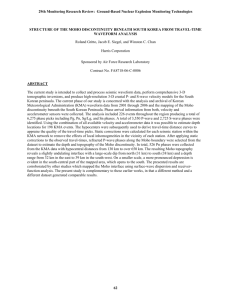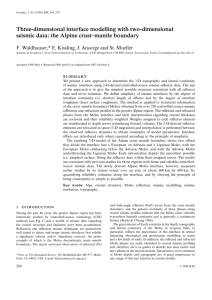On the nature of the Moho: Lithospheric
advertisement
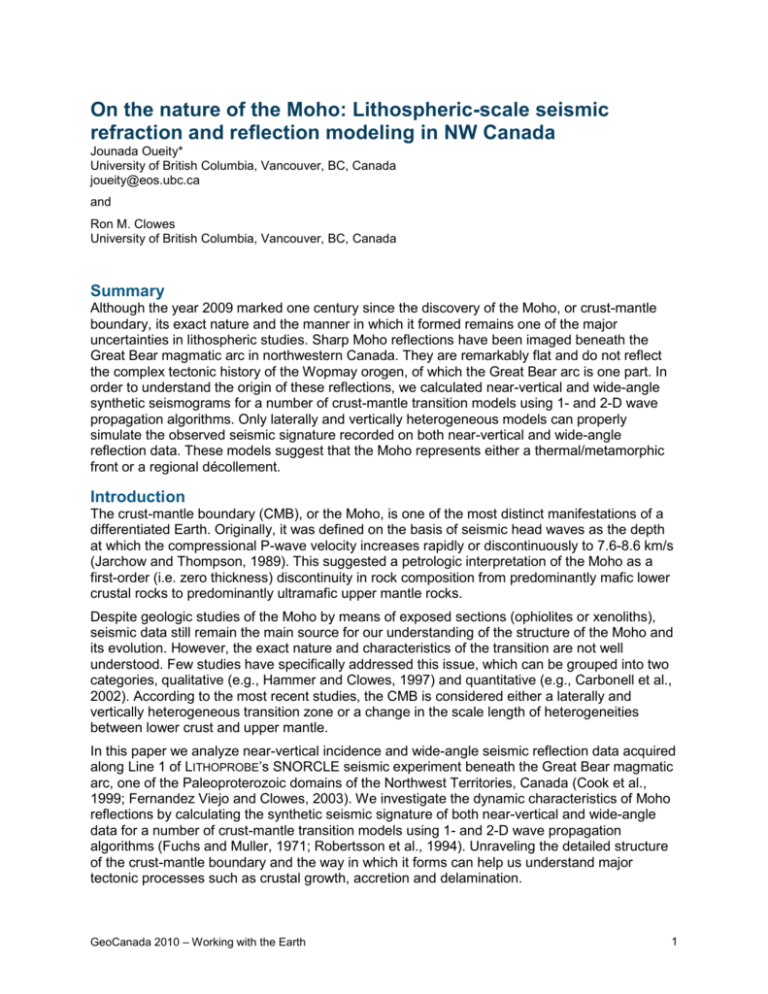
On the nature of the Moho: Lithospheric-scale seismic refraction and reflection modeling in NW Canada Jounada Oueity* University of British Columbia, Vancouver, BC, Canada joueity@eos.ubc.ca and Ron M. Clowes University of British Columbia, Vancouver, BC, Canada Summary Although the year 2009 marked one century since the discovery of the Moho, or crust-mantle boundary, its exact nature and the manner in which it formed remains one of the major uncertainties in lithospheric studies. Sharp Moho reflections have been imaged beneath the Great Bear magmatic arc in northwestern Canada. They are remarkably flat and do not reflect the complex tectonic history of the Wopmay orogen, of which the Great Bear arc is one part. In order to understand the origin of these reflections, we calculated near-vertical and wide-angle synthetic seismograms for a number of crust-mantle transition models using 1- and 2-D wave propagation algorithms. Only laterally and vertically heterogeneous models can properly simulate the observed seismic signature recorded on both near-vertical and wide-angle reflection data. These models suggest that the Moho represents either a thermal/metamorphic front or a regional décollement. Introduction The crust-mantle boundary (CMB), or the Moho, is one of the most distinct manifestations of a differentiated Earth. Originally, it was defined on the basis of seismic head waves as the depth at which the compressional P-wave velocity increases rapidly or discontinuously to 7.6-8.6 km/s (Jarchow and Thompson, 1989). This suggested a petrologic interpretation of the Moho as a first-order (i.e. zero thickness) discontinuity in rock composition from predominantly mafic lower crustal rocks to predominantly ultramafic upper mantle rocks. Despite geologic studies of the Moho by means of exposed sections (ophiolites or xenoliths), seismic data still remain the main source for our understanding of the structure of the Moho and its evolution. However, the exact nature and characteristics of the transition are not well understood. Few studies have specifically addressed this issue, which can be grouped into two categories, qualitative (e.g., Hammer and Clowes, 1997) and quantitative (e.g., Carbonell et al., 2002). According to the most recent studies, the CMB is considered either a laterally and vertically heterogeneous transition zone or a change in the scale length of heterogeneities between lower crust and upper mantle. In this paper we analyze near-vertical incidence and wide-angle seismic reflection data acquired along Line 1 of LITHOPROBE’s SNORCLE seismic experiment beneath the Great Bear magmatic arc, one of the Paleoproterozoic domains of the Northwest Territories, Canada (Cook et al., 1999; Fernandez Viejo and Clowes, 2003). We investigate the dynamic characteristics of Moho reflections by calculating the synthetic seismic signature of both near-vertical and wide-angle data for a number of crust-mantle transition models using 1- and 2-D wave propagation algorithms (Fuchs and Muller, 1971; Robertsson et al., 1994). Unraveling the detailed structure of the crust-mantle boundary and the way in which it forms can help us understand major tectonic processes such as crustal growth, accretion and delamination. GeoCanada 2010 – Working with the Earth 1 Synthetic seismic modeling As represented by wide-angle and near-vertical datasets, the dynamic characteristic of the observed wavefield of the Moho below the Great Bear magmatic are: (1) Prominent PmP phase between 80 and 220 km offsets followed by ~0.5 s long coda, and a very weak amplitude Pn phase observed at offsets > 160 km offset (Fig. 1a). (2) Amplitude behavior of the PmP phase with offset is highly erratic and no common amplitude peak is observed among the different shots. (3) The dominant PmP frequency varies at different offsets between 10 and 14 Hz. However, no clear relation between amplitude spectra and offset is observed. (4) Moho signature on the near-vertical shot gathers is characterized by a very distinct, multicyclic band of reflectors (5-9 cycles) that are laterally variable and piecewise continuous over several kilometres (Fig. 1b). Figure 1: (a) Wide-angle record section for shot 1105 displaying prominent PmP phase and weak Pn phase. Data are bandpass filtered between 3-15 Hz. (b) Near-vertical raw shot gather imaging highly reflective crust and relatively transparent upper mantle. Enlargement of Moho reflections near 11.0 s is shown in inset. We calculate the synthetic seismograms of 1- and 2-D velocity models to determine the extent to which these models can replicate the wavefield characteristics noted above. The dynamic characteristics of these reflections contain valuable information that can help us shed some light on the structure of the crust-mantle transition. These velocity models include: first-order discontinuity; gradient transition; layered transition; and laterally heterogeneous transitions. The layered transition consists of alternating high and low velocity layers with a velocity contrast of 0.6 km/s. For the laterally heterogeneous transitions we investigate a range of velocity models that represent two end members. In one model we use laterally discontinuous layers with variable thicknesses (Fig. 2a) representing an anastomosing layered structure for the transition zone. In the second approach, the velocity model is assumed to be made up of two components: (1) a deterministic background component and (2) a random velocity component comprising a field of small elliptical reflectors embedded in the background velocity field (Fig. GeoCanada 2010 – Working with the Earth 2 2b). The key parameters of these models, which control the seismic signature of the synthetic seismograms, are: the total thickness of the transition zone; the velocity contrast between the transition zone and the surrounding material; and the length of the lateral heterogeneities. (a) (b) Figure 2: (a) 2-D velocity model characterized by discontinuous layers with thicknesses ranging between 100 and 300 m and alternating velocities of 6.9 and 8.1 km/s. (b) 2-D velocity model with randomly distributed ellipses (correlation lengths ax = 1000 m and az= 100 m) and velocities ranging between 7.1 7.8 km/s. Enlargement of Moho is shown in inset. Results Only a laterally and vertically heterogeneous crust-mantle boundary can simulate the dynamic features observed on the wide-angle and near-vertical data (Fig. 3). A 3-km-thick Moho is required to generate 0.5 s long coda. Thicknesses greater than 5 km or less than 2 km produce either a longer coda (~1.0 s) or a PmP phase lacking any visible coda respectively. This transition consists of discontinuous layers/ellipses characterized by variable correlation lengths and velocities. A minimum thickness of 100 m and a 0.2 km/s velocity contrast are needed for Figure 3: (a) Synthetic wide-angle seismogram resulting from laterally and vertically heterogeneous transition zone and simulating SP 1105. Data are band-pass filtered between 3 - 15 Hz. (b) Near-vertical synthetic seismogram resulting from the same transition zone. the layers/ellipses in order to reproduce the reverberatory pattern of the PmP phase. Models with layers/ellipses thicker than 600 m cannot simulate the multicyclic bands of reflectors observed on the near-vertical data. Layers/ellipses that are at least 1 km but no more than 5 km long are required to generate a distinct PmP coda and to achieve the lateral variability seen on the near-vertical data. The amplitude vs. offset curves calculated from the heterogeneous models have a more complicated shape with multiple amplitude peaks in agreement with the GeoCanada 2010 – Working with the Earth 3 calculations from the observed data. The amplitude spectrum of the synthetic PmP phase is characterized by a narrower and more spiked shape as opposed to the broader shape in the case of a simple step discontinuity. The dominant frequency varies randomly between 7 and 12 Hz at different offsets similar to the observed data, and hence no relation between the frequency and offset can be inferred. Discussion and conclusions The Wopmay orogen is an amalgamation of Paleoproterozoic domains that developed and accreted onto the Slave craton between 2.1 Ga and 1.84 Ga by complex geologic processes. Thus, in this region reflection patterns near the crust-mantle boundary are expected to be similarly complex. However, observations along SNORCLE line 1 reveal simple Moho reflections characterized by subhorizontal surfaces and relatively uniform arrival time (~11.0 s) over the entire profile, even beneath regions with different ages such as the Archean Slave province and the Paleoproterozoic Wopmay orogen. This uniformity implies that post-accretion, regionally extensive processes have effectively modified rocks and reset the reflection Moho to a uniform depth (~33 km). Several hypotheses have been proposed for the origin of the continental Moho. These include (1) thermal front (e.g., partial melt and magmatic intrusion), (2) metamorphic front (e.g., mafic granulite to eclogite) and (3) regional décollement. The spatial correlation between the Moho and crustal reflections provides important constraints on the origin of the CMB. Interestingly, seismic data from the lower crust of the Great Bear magmatic arc exhibit two types of correlation. Some of the lower crustal reflections are listric into the Moho suggesting that the crust-mantle boundary is probably a regional décollement. Other reflections appear to be truncated by the Moho, which could be caused by either thermal or metamorphic fronts. We conclude that beneath the Great Bear magmatic arc, an approximately 3 km thick, laterally and vertically heterogeneous crust-mantle boundary properly simulates the dynamic characteristics of the observed wavefield recorded on the near-vertical and wide-angle reflection data. The heterogeneity can be achieved by either laterally discontinuous layering or a lamellae structure with randomly distributed ellipses. These two models can represent different reequilibration mechanisms, one characterized by thermal/metamorphic fronts and another that features a regional décollement. Acknowledgements This study was supported by NSERC Discovery grant 7707-2009 to RMC. References Carbonell, R., J. Gallart and A. Perez-Estaun 2002. Modeling and imaging the Moho transition: the case of the southern Urals, Geophys. J. Int., 149: 134-148. Cook, F.A., van derVelden, A.J., and Hall, K.W., 1999. Frozen subduction in Canada’s Northwest Territories: Lithoprobe deep lithospheric reflection profiling of the western Canadian Shield, Tectonics, 18: 1-24. Fernandez-Viejo, G. and Clowes, R.M., 2003. Lithospheric structure beneath the Archean Slave Province and Proterozoic Wopmay orogen, northwestern Canada, from a LITHOPROBE refraction/wide-angle reflection survey, Geophys. J. Int., 153: 1-19. Fuchs, K and G.Muller 1971. Computation of synthetic seismograms with the reflectivity method and comparison with observations, Geophys. J. Roy. Astr. Soc., 23: 417-433. Hammer, P. T. C. and Clowes, R. M., 1997. Moho reflectivity patterns - a comparison of Canadian LITHOPROBE transects. Tectonophysics 269: 179-198. Jarchow, C. M. and Thomson, G.A., 1989, The Nature of the Mohorovičić discontinuity, Ann. Rev. Earth Planet. Sci., 17, 475-506. Robertsson, J.J. Balnch and W. Symes 1994. Viscoelastic finite-difference modeling, Geophysics, 59: 1444 1456. GeoCanada 2010 – Working with the Earth 4
